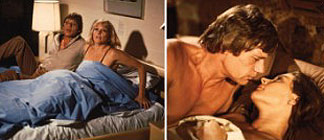|
|
|
|
Duet
For Four
|
 |
|
Duet For Four is clearly Tim Burstall's attempt to make an '80s version of his classic Petersen (1974). It shares many of the earlier film's themes: the mid-life crisis of earthy, working-class Ray Martin (Mike Preston) struggling with the middle-class milieu (corporatism, the artworld, bourgeois sexual manners) into which he has reluctantly but inevitably ascended. David Williamson's script was in fact written in the mid '70s, and the film betrays a '70s (even '60s) sensibility, particularly in the representation of the foppish young artist with the immortal name of Cliff Ingersoll's (Warwick Comber), lover of Ray's wife Margot (Diane Cilento), and the student bohemia in which his daughter Carolina (Sigrid Thornton) lives. Petersen's romantic celebration of its earthy, ocker hero was politically contentious, but at least the film vividly dramatised the various sides of its argument. Duet For Four, by contrast, is a dull film, and Burstall's familiar view of class conflict seems no longer provocative or even terribly accurate. Partly this is because the male pathos here is far softer. Ray's central drives are towards harmony and reconciliation in his family relations, and a return to his former glory days when he worked on the preservation of fine old trains – a dramatically leaden symbol of old-style masculine individualism – rather than squandering his life away as a Toy Man (Williamson's original title) selling mere commodities. The film attempts to build a two-tier dramatic metaphor, paralleling the moves in a corporate take-over with the vicissitudes of personal-sexual relations. Just as the expatriate Aussie-turned-American Al Giesman (Michael Pate) is criticised by the film for his aggressive and invasive business tactics, he also embodies predatory sexuality. (In an Australian vs American joke typical of many films of the period, Geisman extolls porno video – "the screwing's great!" – while the locals regard it with wry, unaroused bemusement). All the film's representative bourgeoisie are also faulted (Margot, Cliff, Carolina's bohemian companions) for being selfishly possessive or cold in relationships. The haven which the film creates for its hero in this heartless world is his relation with Carolina – as strangely charged as it is unexplored, particularly in the absurd scene where Ray, in a rage, breaks into Carolina's house to sieze her childhood doll and bring it to her hospital bed. Duet For Four lacks Burstall's customary directorial flair. Its disconcertingly television-like, perfunctory stylisation earns Brian McFarlane's derogatory comparison with American soap opera (in the book Australian Cinema 1970-1985); and Peter Sullivan's blandly tuneful musical score is especially irritating. It must be mentioned, however, that this very same flatness – the reduction of mise en scène and plot to minimal permutations of characters and motives, as in Mark Rappaport's avant-garde films – inspired perhaps the only favourable account of Duet for Four, Sam Rohdie's review in Cinema Papers (April 1982). Unlikely as it may seem in hindsight, Burstall's method (here and in other films) fleetingly encountered its echo in the academic practice of structuralist-semiotic film analysis. I don't think Petersen would approve. MORE Burstall: Attack Force Z, The Naked Country MORE Williamson: Emerald City © Adrian Martin May 1991 |
![]()